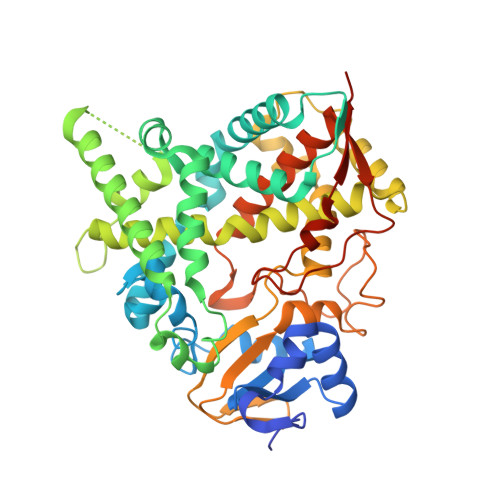4-Aminopyridyl-Based Cyp51 Inhibitors as Anti-Trypanosoma Cruzi Drug Leads with Improved Pharmacokinetic Profile and in Vivo Potency.
Calvet, C.M., Vieira, D.F., Choi, J.Y., Kellar, D., Cameron, M.D., Siqueira-Neto, J.L., Gut, J., Johnston, J.B., Lin, L., Khan, S., Mckerrow, J.H., Roush, W.R., Podust, L.M.(2014) J Med Chem 57: 6989
- PubMed: 25101801
- DOI: https://doi.org/10.1021/jm500448u
- Primary Citation of Related Structures:
4BMM, 4C0C, 4UQH - PubMed Abstract:
CYP51 is a P450 enzyme involved in the biosynthesis of the sterol components of eukaryotic cell membranes. CYP51 inhibitors have been developed to treat infections caused by fungi, and more recently the protozoan parasite Trypanosoma cruzi, the causative agent of Chagas disease. To specifically optimize drug candidates for T. cruzi CYP51 (TcCYP51), we explored the structure-activity relationship (SAR) of a N-indolyl-oxopyridinyl-4-aminopropanyl-based scaffold originally identified in a target-based screen. This scaffold evolved via medicinal chemistry to yield orally bioavailable leads with potent anti-T. cruzi activity in vivo. Using an animal model of infection with a transgenic T. cruzi Y luc strain expressing firefly luciferase, we prioritized the biaryl and N-arylpiperazine analogues by oral bioavailability and potency. The drug-target complexes for both scaffold variants were characterized by X-ray structure analysis. Optimization of both binding mode and pharmacokinetic properties of these compounds led to potent inhibitors against experimental T. cruzi infection.
Organizational Affiliation:
Center for Discovery and Innovation in Parasitic Diseases, ‡Department of Pathology and §Department of Medicine, ∥Department of Pharmaceutical Chemistry, University of California San Francisco , San Francisco, California 94158, United States.
















